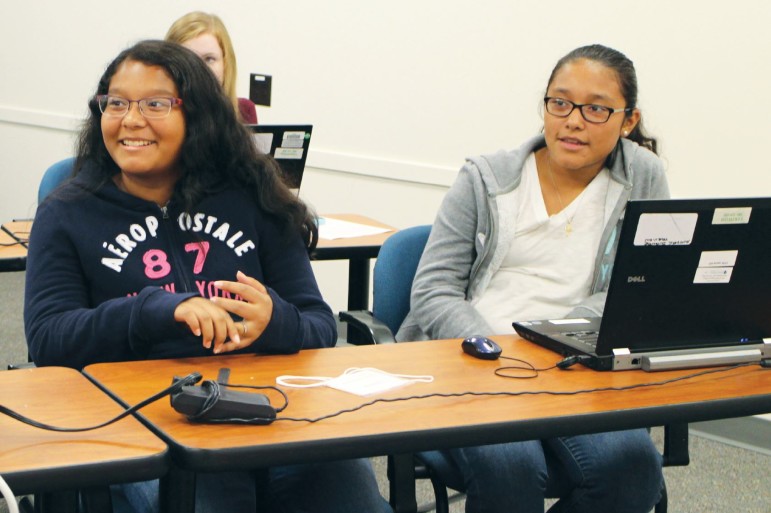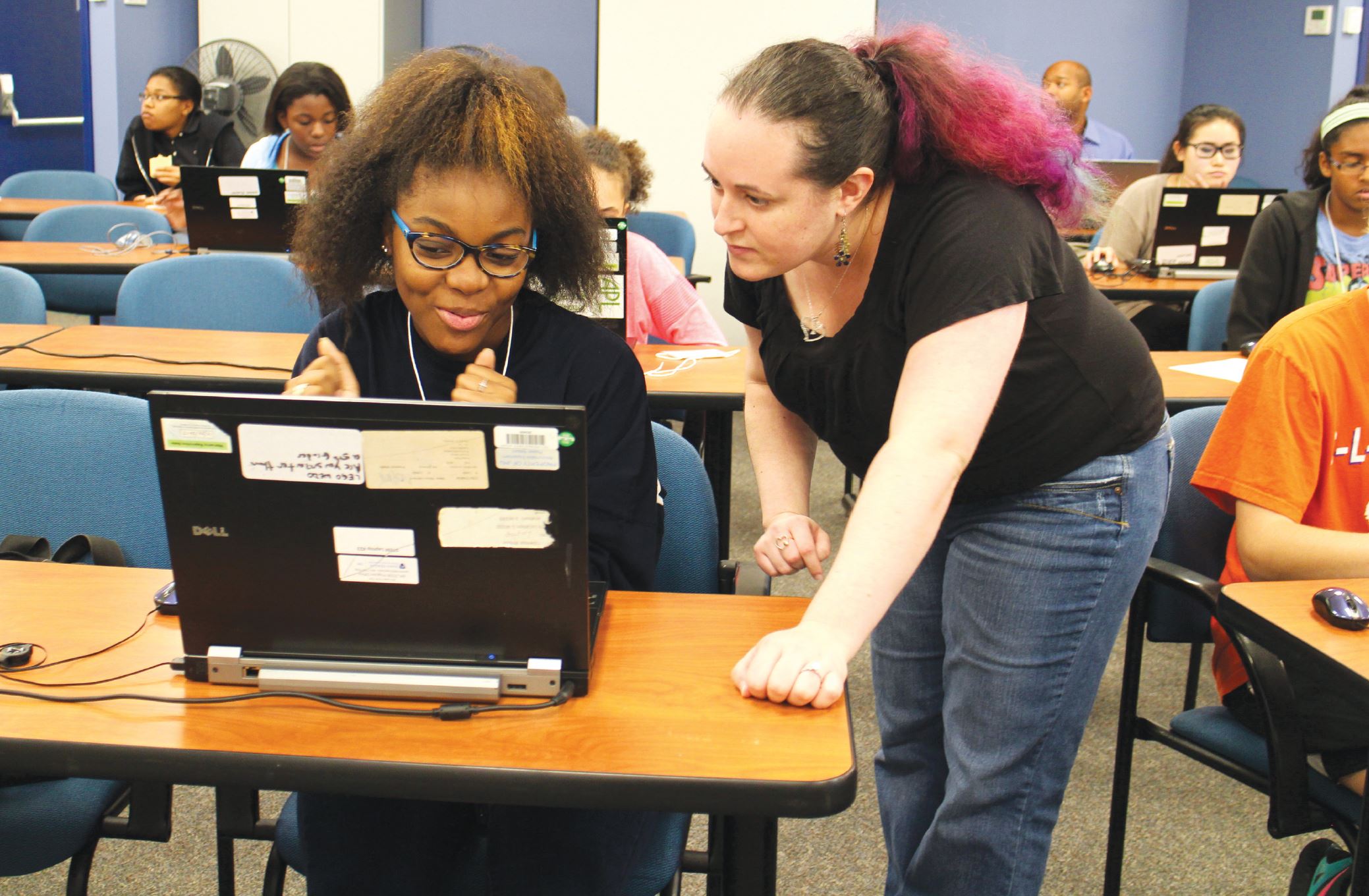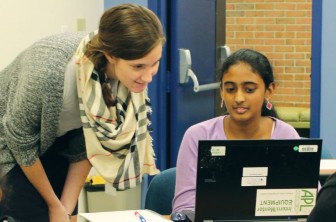Kennedy Thompson wants to be an engineer when she grows up.
Kennedy, 13, has always loved math and science. She’s been to space camp and to robotics programming classes to learn as much as she can to help achieve her dream.
Earlier this fall, Kennedy joined the Girls Who Code chapter at the Johns Hopkins University Applied Physics Laboratory, hoping that an introduction to coding would be one more step on her path.
She was nervous the first day, but as the girls introduced themselves and got to know the mentors from the lab who would lead their class, she started to relax.
“It should be exciting because it looks like coding is fun and could bring a lot of possibilities,” she said.
That’s what the leaders at the lab, and in similar programs around the country, are hoping: that an introduction to coding will show girls new possibilities for their lives.
Technology programs for girls
The organization is one in a boom of technology programs for girls that emphasize computer science, including coding, as part of a larger effort to encourage girls to participate in science, technology, engineering and math (STEM) fields.
High-profile groups like Girls Who Code and Black Girls Code have launched after-school and summer programs, while other after-school programs are eager to add technology components to their offerings.
Researchers and practitioners said girls deserve to experience the fun and challenges of STEM fields, and to be literate in the fields that shape so much of their day-to-day lives.
An early interest also can shape girls’ academic and career paths, directing them toward STEM jobs, where women are underrepresented and more perspectives are needed, they said.
“It’s really important for diverse perspectives to take on the challenges that we have in those fields,” said Brenda Britsch, co-principal investigator at the National Girls Collaborative Project, which helps girlserving organizations connect around STEM issues.
Women have earned about 57 percent of all bachelor’s degrees, including about half of science and engineering degrees, since the late 1990s, according to the National Science Foundation (NSF). However, women’s participation across science and engineering fields varies and is lowest in engineering, science and physics. In 2012, women earned 18.2 percent of computer science degrees.
In the working world, women make up 25.4 percent of computer or math scientists and 14.8 percent of engineers, according to NSF.
Solving problems
Britsch said the strategies to engage girls in STEM hold true across its disciplines, including technology.
She said research shows one key way to engage girls in STEM programs is to make projects relevant to them. After-school programs are a natural setting to encourage girls to think about the problems they would like to solve in their communities, she said.

Sisters Vanessa Peñarrieta, 12, and Jaquelin Peñarrieta, 13, listen to Girls Who Code instructors as part of the club’s 40 hours of instruction provided to participants.
Britsch said hands-on programs also are important, as is making sure program leaders don’t just encourage girls to sign up and then leave them on their own.
“If you’re not comfortable getting in there on the computer or working on the robotics or whatever it is, you’re not going to be as confident and interested as you can be,” she said.
[Related: Do After-school STEM Programs Lead to Science Careers? Should They?]
Role models
Practitioners also have found role models can be critical for girls, said Britsch.
“For anyone who doesn’t see themselves represented in science, engineering, technology or math, it’s important to expose them to people who work in the field,” she said.
The leaders of Techbridge, a 16-year-old organization that runs after-school and summer STEM programs for girls, have long thought about what makes a good mentor.
Many technology companies are eager to share their expertise with girls, but they may need guidance in how to do so most effectively.
It’s not enough to have a computer engineer rattle off a description of what they do every day at work, said Linda Kekelis, executive director and CEO of Techbridge.
Role models need to share ageappropriate information that highlights why they enjoy their work but also acknowledges the challenges, she said. The group has found girls also like to have a full portrait of someone, to understand how their families and hobbies fit alongside their professional life.
Building a program
Pooja Chandrashekar, 18, is the founder of the youth-led group ProjectCSGIRLS, a national technology competition for middle school-aged girls. She started the group in high school, after she often found herself one of the few girls in her computer science classes.
Last year, 900 girls across the country participated in the competition. This year, Chandrashekar is aiming for 5,000. The girls are asked to tackle a social problem of their choosing in one of three themes: global health, a safer world and intelligent technology.
The girls’ projects have included a personalized lip reading system for veterans, cybersecurity algorithms and glucose-sensing devices.
Chandrashekar said she sees throughout the competition that a focus on how technology helps people, in addition to how it works, matters to the girls in the competition.
“We want to show them how they can use technology to change the world and develop tools to help others,” she said.
During the competition, the girls have the option to be paired with a STEM professional, who can help them think about their college plans or career options. At the same time, the young women who run the organization are front-and-center on the ProjectCSGirls website and make time to connect with participants.
“That speaks to them and resonates with them. It gives them a concrete idea of who they could become in just a few years,” Chandrashekar said.
Chandrashekar said the group’s use of role models, real-life situations and hands-on projects came naturally to the young women who run the group. They know what sparked their love of technology and inspired them to pursue their passions.
“We all work together to build what we would have liked to have seen,” she said.
Resources: Girls, coding and STEM
-
Techbridge offers role model training and resources to help programs cultivate mentors. www.techbridgegirls.org
- The National Girls Collaborative Project and other groups run the Connectory at theconnectory.org, where program providers can find other STEM programs and providers in their area.
- Afterschool Alliance offers assessment tools, professional development resources and curriculum at afterschoolalliance.org/STEM-RESOURCES.cfm.
- ProjectCSGirls 2015-2016 competition is underway. Registration closes Feb. 15. Find out more at projectcsgirls.com.
- Learn how to start a Girls Who Code club or find one nearby at girlswhocode.com.
- Find out more about Black Girls Code hackathons at blackgirlscode.com.
More related articles:
STEM Education Bill With OST Focus Signed Into Law
Regional Realities: Girls Not Choosing Careers of the Future
Creating Economic Opportunity for Girls by Taking a Gender Lens to Programs & Policies
Young Women Organize Around Day of the Girl to Highlight Issues































